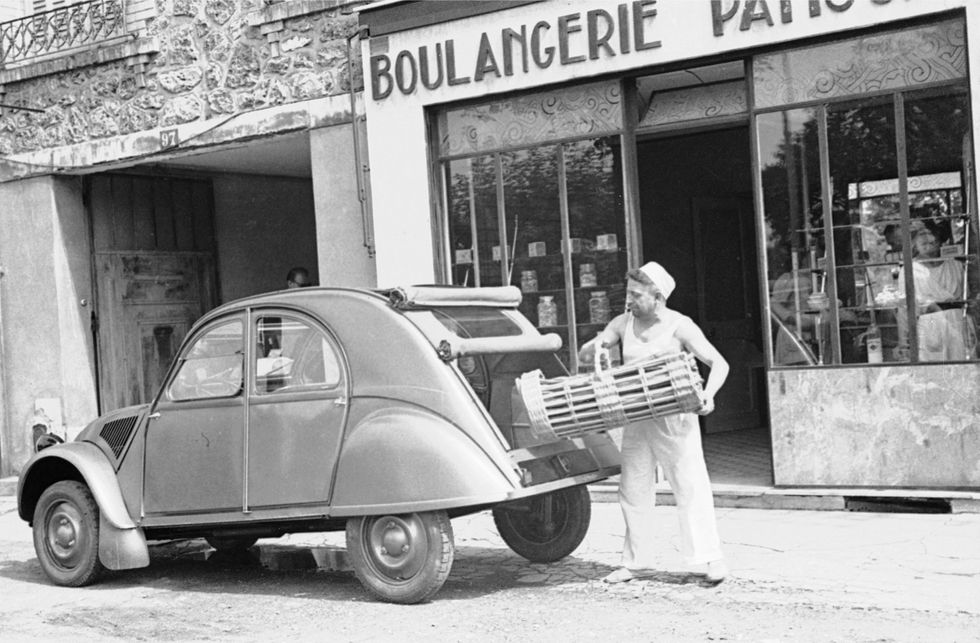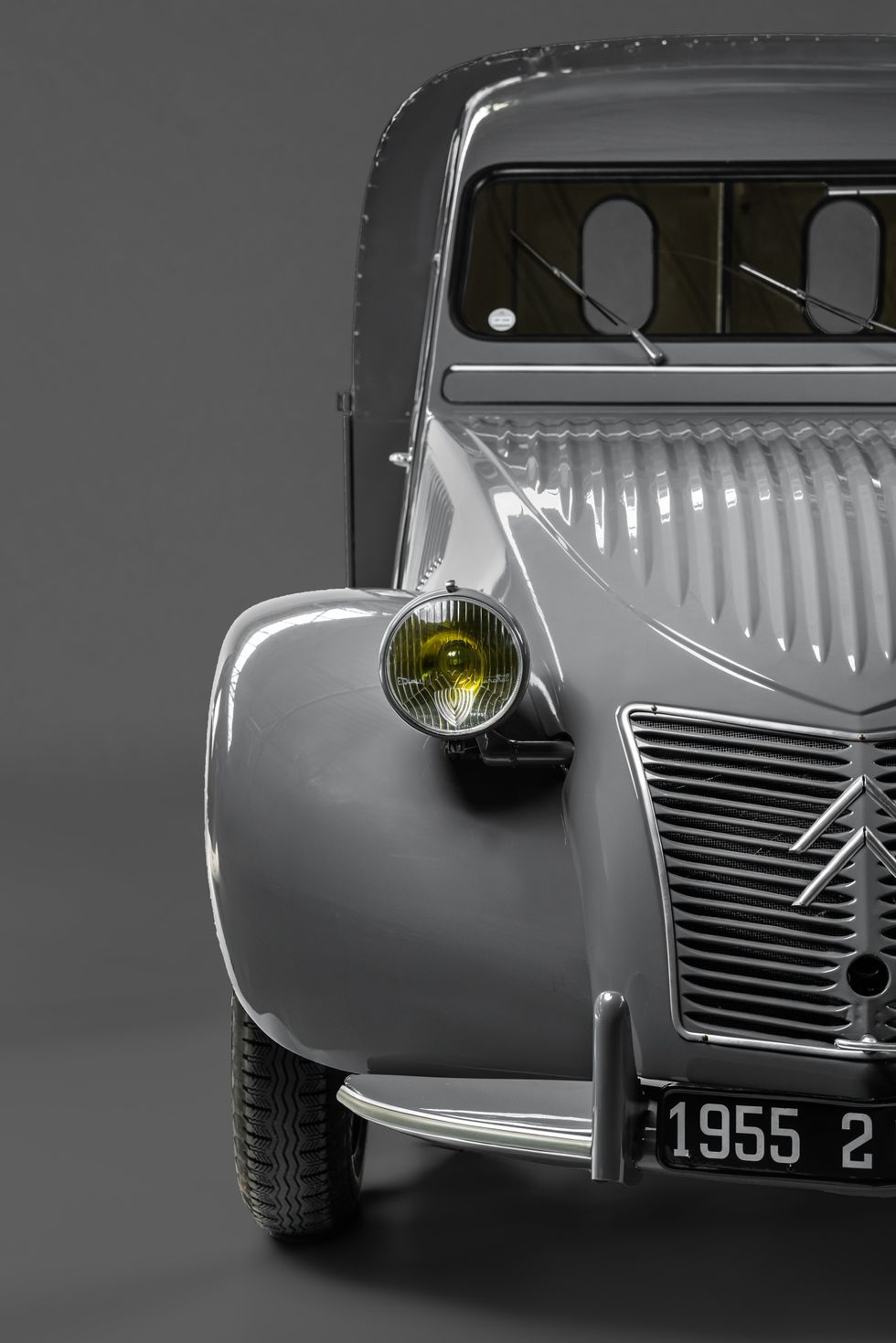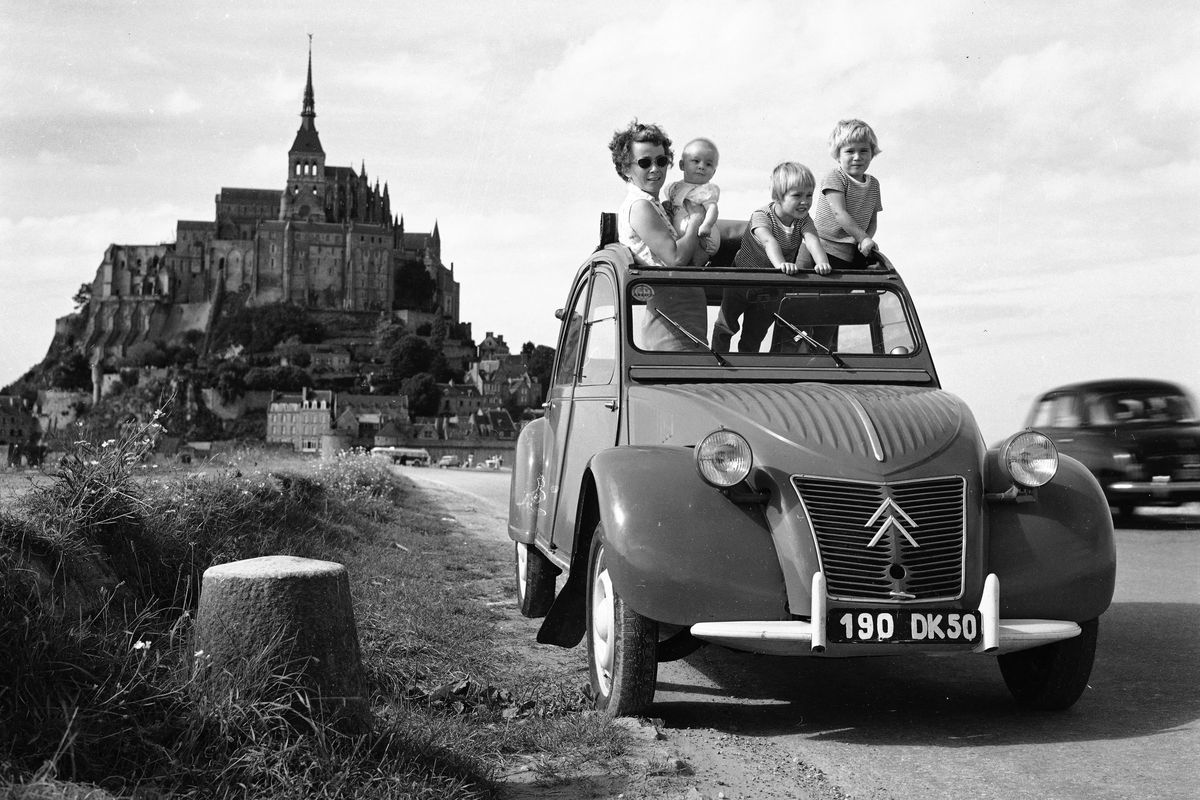It has been almost 75 years since Citroën unveiled its most iconic model, the 2 CV, at the Paris Motor Show on October 7, 1948. The automaker sold 5,114,969 examples, including 1,246,335 2 CV vans, until the very last 2 CV rolled out of the Mangualde factory in Portugal on July 27, 1990, 42 years after the model’s launch.
The 2 CV began life in the mid-thirties as the “TVP” project, which stood for Toute Petite Voiture, or very small car. The aim of the project was to provide an economical, versatile car that would be affordable for people living on a lower income. The first roadworthy prototype was built in 1937, weighing in at just 370 kg (816 lbs.) and wearing one headlight, it could comfortably carry up to four passengers and 50 kg (100 lbs.) of luggage. The war outbreak but an end to the project and 250 pre-production models were destroyed before the scheduled unveiling at the 1939 Paris Motor Show, except for four examples which were hidden away at the Citroën Test Centre at La Ferté-Vidame.
The 2 CV was a compact car with a whopping 9 bhp powered by a 375 cc, air-cooled, flat-twin engine capable of a top speed of 50 km/h (31 mph). Its unique design, level of comfort, economical functionality, and infinite amount of uses quickly won over a large part of the population when it finally went into production in July 1949. Citroën was overwhelmed with orders by 1950, with delivery times extending up to 6 years.

The 2 CV is known around the world for many things, and its reputation earned several nicknames. Some of the best known are "Deuche" or "Deux-Chevaux" for its two-tax horsepower, “Ugly Duckling,” “Tin Snail,” “Dolly,” and “Upside-down Pram”. Ten special editions were launched during the model’s 42-year run, including the Spot, the Charleston and the Cocorico. In keeping up with customer demands, the 2 CV also saw many changes, like the launch of the 2 CV AU van in 1951, and the 2 CV AZ packed with a 12 bhp engine paired with a centrifugal clutch in 1954.
In honor of the 2 CV model’s history, Citroën arranged a photoshoot that features eight important iconic 2 CVs from the Citroën Conservatoire. The automaker also arranged a public celebration on October 7 at the Conservatoire Citroën in Aulnay-sous-Bois. Beginning at 10 a.m., visitors can view 75 2 CVs that have been restored and passionately maintained by private collectors. Owners will be present to talk about their cars. Visitors will also have the opportunity to visit the Conservatoire, which houses around 250 iconic models from the double-chevron brand.
For those unable to attend the in-person event, Citroën has supplied the following photos and video featuring eight iconic 2 CVs:
Citroën 2 CV 4 x 4 “Sahara”
The 2 CV 4 x 4 “Sahara”, with four-wheel drive and two engines that enable it to negotiate gradients of over 40 per cent in the sand.




Citroën 2 CV AZU
The 2 CV AZU, a 2 CV van produced from 1954 until March 1978, has a large load capacity and rear “cupboard” doors for easy loading.




Citroën 2 CV 6 by Hermès
The 2 CV 6 by Hermès, dressed by Hermès inside and out, was shown at the 2008 Paris Motor Show to mark the 60th birthday of the 2 CV.




Citroën 2 CV Spot
The 2 CV Spot, Citroën's first special edition, 1,800 of which were built with two-tone upholstery and bodywork based on a design by stylist Serge Gevin.




Citroën 2 CV A Right-Hand-Drive
The right-hand-drive 2 CV A, built in Slough (UK) from 1953. It had a sheet-metal trunk and opening rear windows. To this day, it is the oldest British 2 CV in Europe.




Citroën 2 CV 6 Spécial
The 2 CV 6 Spécial, one of the last 2 CVs produced at the Levallois plant in 1988.




Citroën 2 CV A
The 2 CV A, one of 250 prototypes built in 1939 for the Motor Show, which ended up being cancelled because of the Second World War. One of the four remaining vehicles at the Citroën Conservatoire.




Citroën CV A Berline
The 2 CV A Berline (1950), identical to the one unveiled by Pierre Boulanger at the opening of the Paris Motor Show in 1948.




Who doesn’t remember their first car? The joy it brought, the pride of ownership and the lasting memories it created along the way. These are remembrances that you shared for a lifetime. Most of us will only be able to reminisce about these classic rides of our youth, helped along with possibly some pictures, movies and maybe a trinket or two kept from that first car that was saved before it was cast off to a new owner, or sadly, sent to that big scrap heap in the sky.
Luckily, Nick Pezzolla of East Greenbush, New York was one of those guys who was ahead of the curve and held on to that first ride. Nick scored this tasty GTO when he was just fifteen and had the wherewithal to keep a torqued-up grip on its title, holding on to his prized Pontiac since that fateful day he brought it home. After thirty plus years of ownership, Nick still gets a thrill getting behind the wheel of his Goat, the one car that has been there through thick and thin since his high school days.

Photo: Scott Lachenauer
Nick grew up like many of us, infatuated with muscle cars at an early age. “When I was six or seven, I received my first model kit. My dad pretty much built it, but soon after I was totally obsessed with building muscle car models. At ten years old I received a kit of a ’65 GTO. I was in love. At that moment I vowed to get a GTO as my first car. It was a necessity as far as I was concerned," he explained.
By the time Nick turned thirteen, he was on the hunt for his first car. “If we saw a GTO in a parking lot, we left a note on it. If it was in a driveway, we knocked on the door and asked if they were interested in selling. We soon found out that the people that really wanted to sell their rides, owned cars that were typically cobbled together from parts, or full of Bondo. Dad was adamant that I buy something in good condition, and hopefully get one with the original drivetrain so it would appreciate in value for years to come.”
Fast forward to the spring of 1993. “I was turning sixteen at the end of July and I still didn’t have a car.” That's when it happened: Nick’s best friend at the time was eighteen months older and already had his license, which helped in scouting the local area. One day he received a tip from his buddy that he had spotted a gold GTO on someone’s lawn for sale. The kicker was that it was right in his town. “That was weird to us because it’s a pretty small town and we had never seen that car before.”

Photo: Scott Lachenauer
Regardless, Nick and his friend went and checked it out. What the car turned out to be was a 1970 GTO in Granada Gold with its original 400-cu.in. engine, backed by an automatic transmission. Somehow this golden treasure made its way all the way from Tacoma, Washington to the east coast, and had lived out its last few years right there in town. “It still had a 1988 car show plaque from Tacoma affixed to the dash,” according to Nick.
Amazingly, this twenty-three-year-old Goat was in good shape, so Nick decided to have his dad have a look at it to get his opinion. Once there, dad took the GTO out for a spin, with non-licensed Nick riding shotgun. “I remember having perma-grin while riding shotgun during the test drive. I couldn't contain myself.”
Dad agreed that this Poncho was the perfect starter car for his son. The only thing left was financing, and that was done through the family. “I borrowed half the money from Grandma, who was on a fixed income, and over the next couple months made three payments to the seller to meet the $5000 agreed on purchase price.”

Photo: Scott Lachenauer
After it was paid up, the owner brought Nick’s new ride to his house and delivered it to the young gun, which turned out not to be the best idea. “My older brother and I were home alone that day while my parents were out at work. Since it was summertime, my brother would have his friends visit and go swimming in our pool. If they were gonna be there for a while, they would let me take their license plates of their respective cars and I would put them on the Goat so I could take it out for mischief around town. I guess no harm, no foul, right?"
Nick got his own insurance policy and had the GTO road-ready prior to his birthday. Two weeks later he received his New York State license and drove it to the first day of school that September. “I felt like I was king when I was behind the wheel in that GTO.” From that point on, Nick always had a bad-weather beater and stored his Goat through the snowy, salty winters of the Northeast. “There were times where I had the opportunity to sell it, but never did, because I didn’t want to have the same regrets my dad had after selling his original Challenger.”
Since then, Nick has kept the GTO’s looks up, and has plans for the car’s future. “I had it repainted in 2012 and we did the interior. I plan to pull the engine, since I've never had it out, and give the mill a full rebuild. I wanted to do it last summer for our 30th anniversary together, but after the passing of my dad in the spring, it just wasn't in the cards. Hopefully this is the year I get it done. Time will tell.”.

Photo: Scott Lachenauer
Since then, Nick has kept the GTO’s looks up, and has plans for the car’s future. “I had it repainted in 2012 and we did the interior. I plan to pull the engine, since I've never had it out, and give the mill a full rebuild. I wanted to do it last summer for our 30th anniversary together, but after the passing of my dad in the spring, it just wasn't in the cards. Hopefully this is the year I get it done. Time will tell.”
Chevy/GMC Trucks 1967-1972: How To Build And Modify

By Jim Pickering
- CarTech Publishing
- cartechbooks.com/SA528
- 800-551-4754
- ISBN 9781613257470
- $36.95
- ★★★☆
The 1967-’72 “Action Line” trucks from Chevrolet and GMC moved the pickup game forward with attractive new styling, clever engineering, and a focus on cabin comfort. Two- and four-wheel drive, Fleetside and Stepside bed styles in 6 1/2-foot or 8-foot length–these haulers sold in big numbers and have been collectible for decades. Survivors have become popular subjects for restomodding since their straightforward construction and great parts availability makes them ripe for performance and comfort updates. If you’re buying or already own a C10-K10/1500 half-ton or C20-K20/2500 three-quarter ton truck, and want to make it more everyday usable, you’ll benefit from a copy of the latest entry in CarTech’s Performance How-To series.
Author Jim Pickering walks readers through customizing his own ’67 C20. He offers a historical overview of this era of GM truck and a buyer’s guide, before going step-by-step into how to take them apart, repair rust in the cab and bed, and alter the frame. Chapters include upgrading the front and rear suspensions, modifying brakes with factory or aftermarket parts, building axles, choosing between engine options, and improving cab comforts. The 176-page softcover contains nearly 500 detailed, captioned color photos and offers enthusiasts an excellent overview of what a vintage Chevy and GMC pickup can become with desire, skill, and money.
Spellbinder: The Life Of James J. Nance, Volumes One and Two



























